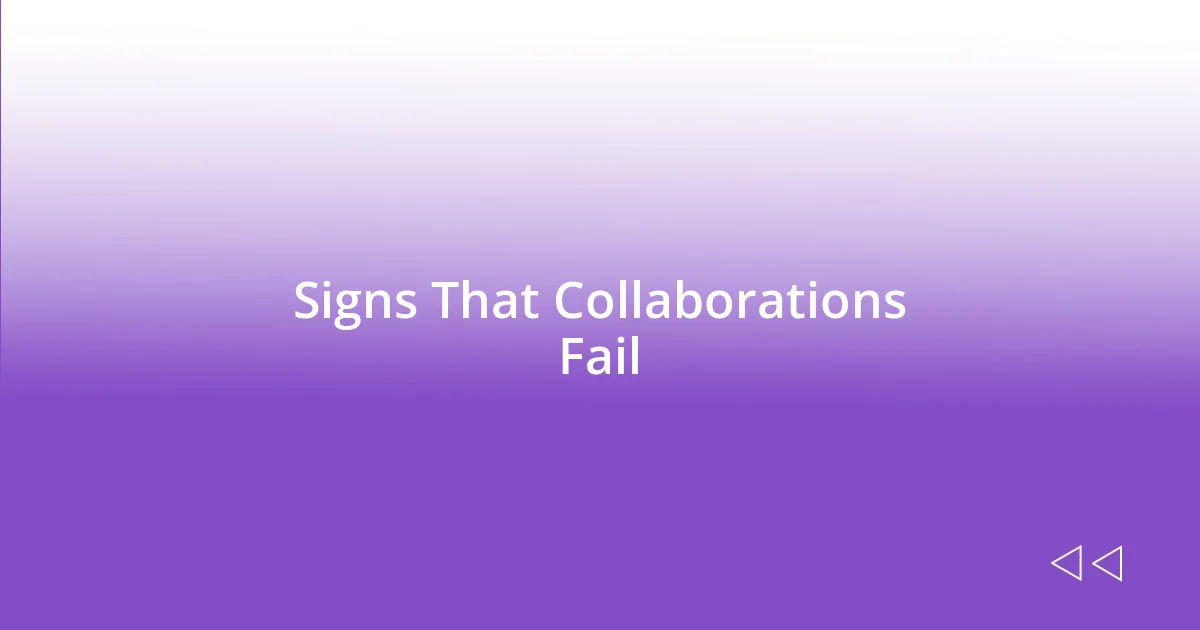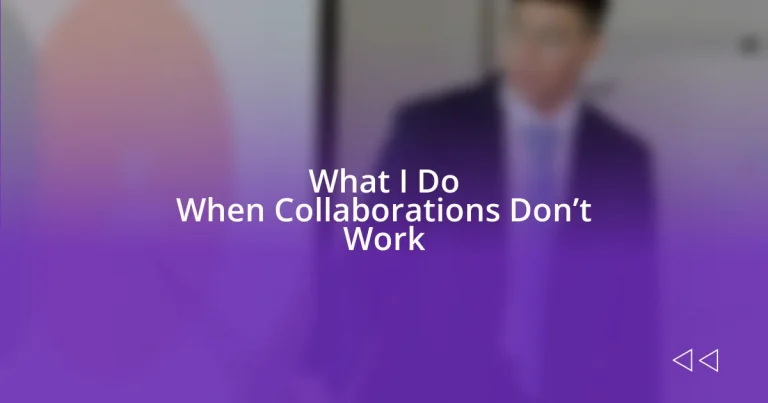Key takeaways:
- Collaboration challenges often arise from differing communication styles, unclear expectations, and time constraints, highlighting the importance of open dialogue and stress management.
- Signs of failing collaborations include declining communication, loss of accountability, and waning enthusiasm, indicating the need for corrective measures.
- Emphasizing effective communication, trust-building, and accountability are crucial for successful collaboration, alongside recognizing when to let go and learning from experiences.

Understanding Collaboration Challenges
Collaboration challenges often stem from differing expectations and communication styles. I remember a project where I assumed my team members understood the vision as clearly as I did. It turned out we were all on different pages, leading to frustrations that could have been avoided with clearer dialogue. Have you ever felt that disconnect in a group setting?
Another key issue is the clash of personalities. I once worked alongside a colleague whose approach to feedback was straightforward, almost abrasive. In contrast, I leaned towards a more supportive method. This difference created tension, making it difficult to progress. It’s worth asking yourself: How do individual styles affect team dynamics?
Finally, time constraints can accelerate collaboration stress. I recall a particularly tight deadline where my team was under immense pressure, and the collaborative spirit deteriorated into hurried decisions and misunderstandings. It’s crucial to recognize how stress impacts collaboration—have you noticed that ticking clock influencing your team’s interactions? Understanding these dimensions can help us navigate challenges more effectively.

Signs That Collaborations Fail
Sometimes, I notice glaring signs that a collaboration is on shaky ground. One major indicator is when team members stop communicating regularly. In one project, we went from daily check-ins to not speaking for days, and that silence felt like an alarm bell warning us of impending failure. Have you ever experienced that awkward quiet where everyone seems to shy away from discussing the project’s status?
Another sign that things have gone awry is when tasks start slipping through the cracks. I was in a situation where everyone assumed someone else was taking care of important responsibilities. As deadlines approached, it became evident that no one had a clear idea of who was handling what, creating chaos that could have been easily avoided with proper accountability measures. It’s painful to watch a group struggle with overlapping duties, isn’t it?
Lastly, an unmistakable sign of failure is when enthusiasm wanes. I remember collaborating on a marketing campaign; at first, the energy was infectious, but as challenges surfaced, so did a collective feeling of defeat. When the original excitement gives way to resignation, it spells trouble for any collaboration. Have you felt that shift from eagerness to apathy in team settings? It can be disheartening and is often a clear warning that change is needed.
| Signs of Collaboration Failure | Emotional Insights |
|---|---|
| Declining Communication | Silence can feel like an ominous warning, leaving team members wondering about project status. |
| Lost Accountability | When tasks go unclaimed, chaos ensues, reflecting a lack of clarity and responsibility. |
| Diminished Enthusiasm | A shift from excitement to apathy indicates a deep-rooted issue within the collaboration. |

Assessing My Role in Failure
Assessing my role in the failure of a collaboration is a necessary step for growth. I often reflect on past experiences to pinpoint how my actions or inactions contributed to the breakdown. For instance, I found myself often assuming others were on the same track, which resulted in misaligned expectations. It’s a tough pill to swallow, but acknowledging that I played a part can feel transformative.
- Recognizing my assumptions about team members’ understanding
- Identifying communication lapses on my part
- Acknowledging my tendency to avoid difficult conversations
- Understanding how my personal stress influenced my engagement
Additionally, I realized that my emotional responses during collaborations, such as frustration or discouragement, sometimes affected the group dynamic. In a design project, I became overwhelmed by my own perfectionism, inadvertently stifling creativity. This introspection allows me to consider how my mindset can impact others, which has been invaluable for my personal and professional growth.

Strategies for Effective Communication
Effective communication is the backbone of any successful collaboration, and I’ve learned a few strategies along the way that can really make a difference. One approach I find particularly helpful is to schedule regular check-ins, even if they’re brief. During a tech project I was involved in, I insisted on a quick weekly touchpoint. Surprisingly, it fostered openness and accountability, creating a space where everyone felt comfortable voicing concerns and updates. Have you ever noticed how a little structure can help the whole team feel more engaged?
Another key strategy I’ve adopted is active listening. I recall a time when our group was deliberating on a marketing strategy; instead of just waiting for my turn to speak, I made a conscious effort to listen closely to my teammates. This shift changed the tone of the discussion, enhancing trust and collaboration. It dawned on me that acknowledging others’ perspectives can lead to richer ideas and solutions. It’s amazing how much insight one can gain by simply listening.
Lastly, I emphasize the importance of setting clear expectations. In a recent collaboration, I distributed a detailed project outline that included not just deadlines but also individual roles. I found that when everyone knows their responsibilities, it diminishes misunderstandings and overlapping duties. How often do we underestimate the power of clarity in our communications? It can truly be a game-changer in maintaining team morale and productivity.

Building Trust with Collaborators
Building trust with collaborators is essential for any project’s success. From my experience, one of the most effective ways to foster trust is by being genuine and open about my intentions. I remember when I worked on a community event, and I shared my vision with the team, admitting my fears about its success. By being vulnerable, I noticed others started sharing their concerns too. It’s funny how that honesty can create a safe space—it’s almost like we release the pressure valve together.
Another aspect I focus on is accountability. There was a time when a project I led fell behind schedule. I took responsibility in front of the team, owning the delays while also encouraging others to share their own challenges. This transparency changed the dynamics; we all felt empowered to hold each other accountable without the fear of judgment. Because after all, isn’t it easier to trust someone who shows accountability?
Lastly, I’ve learned to celebrate small victories. In one collaboration, after finalizing a difficult phase of our project, I organized a small thank-you gathering where we acknowledged everyone’s hard work. This small gesture made a huge difference in boosting morale and reinforcing our connections. I often ask myself, how much do we value our contributions in the collaborative environment? Recognizing effort is a simple yet powerful way to build trust, and it can turn a group of individuals into a cohesive, supportive team.

Knowing When to Let Go
Knowing when to let go can feel like a daunting decision, and I’ve been there more times than I’d care to admit. There was a project where I poured my heart into developing a joint marketing campaign, but despite everyone’s hard work, it just wasn’t aligning. At first, I hesitated to acknowledge the signs—after all, we had invested so much. But eventually, I realized that holding on too long was doing us more harm than good. It’s tough, isn’t it, when the passion starts to fade and the energy feels depleted?
In my experience, trusting your instincts is crucial in these moments. I recall another collaboration where the team’s enthusiasm nosedived halfway through. No matter how much I tried to reignite that spark, our discussions turned flat; it was like pushing a boulder uphill. Recognizing that our creative energies had waned was a painful yet necessary realization. Sometimes, that gut feeling is the clearest indicator that it’s time to pivot or even break the collaboration.
When I chose to move on from that stagnant project, relief washed over me. I learned that letting go doesn’t equate to failure; rather, it’s often a stepping stone toward something better. Reflecting on it now, I wonder—how many of us cling to partnerships simply out of nostalgia for what could have been? Embracing the notion that not all collaborations are meant to thrive can free us to explore new avenues that align with our vision.

Learning and Moving Forward
Embracing the lessons from challenging collaborations has been essential in my growth. I remember a time when a collaboration unraveled, leaving me feeling frustrated and defeated. Instead of wallowing in that negativity, I took a step back and analyzed what went wrong. What could I learn from the miscommunication and missed deadlines? I realized that identifying and addressing underlying issues early on could have completely transformed the experience.
Another valuable takeaway was the importance of feedback. In a project that didn’t pan out, I awkwardly navigated the aftermath until a teammate suggested a debrief. Once we sat down to discuss our experiences, it felt as though the clouds began to lift. Hearing everyone’s perspectives illuminated crucial points I hadn’t considered. It’s interesting how we often overlook this straightforward step—could we improve future efforts simply by making it a habit to share insights?
Now, I actively seek feedback after every collaboration, no matter the outcome. I’ve discovered that doing so not only sharpens my skills but also cultivates a growth mindset among my peers. It’s astonishing how the collaborative spirit can thrive even after setbacks if we prioritize learning effectively. When faced with challenges, I ask myself: are we truly leveraging these experiences to become better versions of ourselves and collaborators? By embracing a proactive approach, I’ve noticed my resilience has only strengthened, preparing me for even greater opportunities ahead.














